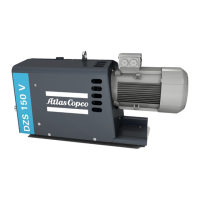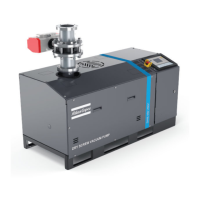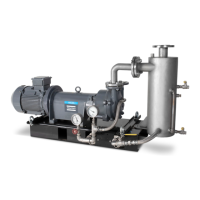28 6996 0223 70
Location:
Locate the pump horizontally on a level surface. Ensure surface must be clean, well lit, well ventilated and capable
of taking the weight of the pump. The entire length of the frame base must be supported. Insert shim, where necessary
(Do not use wood).
Anchoring to the ground is not necessary but essential if mounted on a frame or a structure that may result in the
pump moving. Always consider using anti-vibration mounts.
Ambient temperature should not exceed temperatures listed in chapter “Technical data”. All models are intended for
indoor installation. Outdoor installations will require additional weather protection. Do not locate the unit where the
hot air from other pumps or heat generating equipment may be drawn in to the unit. Never restrict the flow of exhaust
air from the pump. The hot exhaust air must be exhausted to the outside to prevent high ambient conditions in the
room. The limiting ambient conditions are 0°C to 40°C (32°F to 104°F) and atmospheric pressure. Please consult the
manufacturer, if operating outside of the criteria.
The pump is designed to be located and operated in safe environment areas where there this is no risk of explosion.
Environmental conditions must comply with the protection class of the motor as depicted on its name plate.
Consideration must be given to the safety and welfare of personnel. Thermal insulation should be provided to offer
protection against the intense heat which can be generated around the exhaust of the pump.
Piping connections:
Process connection, exhaust pipework and associated component must be installed in line with general engineering
practices and abide by local by-laws and regulations. Good installation practice include the correct sizing of the
process pipework to reduce a loss of performance and to prevent damage to the pump. Ideally all pipework, filters
and accessories should be fully supported to reduce physical stress on the pump.
Vibration transmittal through the pipework must be minimized. Pipework should slope away from the pump to reduce
the risk of condensate liquid running back in the pump. The filtration equipment should be fitted if there is a chance
of particulate carry-over. 5 micron or less is ideal.
Pipework should be straight as possible with no tight bends and convoluted runs. It should be sized correctly to
reduce losses. Use the same diameter of pipe for pump process connection. Pipe runs that are convoluted or lengthy
(beyond 10 meters) need careful consideration and proper sizing.
Make sure all piping connections from the pump to the point of use are leak tight and secure. Use easy to release
and flexible connection at the point of final connection to the pump.
Process isolation valves are also essential but in the case of vacuum pump, never isolate the exhaust that may lead
to high back-pressure. Drip-leg drains or low position drain point is also good installation practice. The exhaust
silencer is fitted with a drain plug or drain tab and consideration should be given to adequately dealing with
condensate drain off.
A variety of pipe material are available for installation but they must be compatible with the process medium. The
discharge air can run up to 250 °C (482 °F), so piping should be suitable to handle this temperature.
At 2.5 bar (g) pressure, over-pressure pump can generate hot air up to 250°C, the pipe must
be rated accordingly.
Leakage in the pipework and accessories is a major factor that affect the performance and efficiency of the pump.
Regular inspection and leak testing is recommended. It is essential that the internals of the pipe is cleared of foreign
objects before starting the pump. Installation of an inlet protection gauge is good practice to safeguard the pump.
Ventilation:
Avoid recirculating the hot air from the pump ventilation ports back it to the pumps cooling system and relief valve.
This will cause inadequate cooling and unnecessary overheating.
The air velocity to the ventilation ducts to be limited to 5 m/s
The maximum air temperature at intake opening is 40°C (104°F), (minimum 0°C / 32°F)
Ventilation alternative 1 and 3 (refer the Installation proposal Drawings):
The required ventilation to limit pump room temperature can be calculated from:
Qv = 1.06 N / T
Where, Qv = required cooling air flow (m
3
/s)
N = Nominal motor power of pump (kW)
T = Temperature increase in pump room. (°C)
Ventilation alternative 2 and 4 (refer Installation proposal Drawings):

